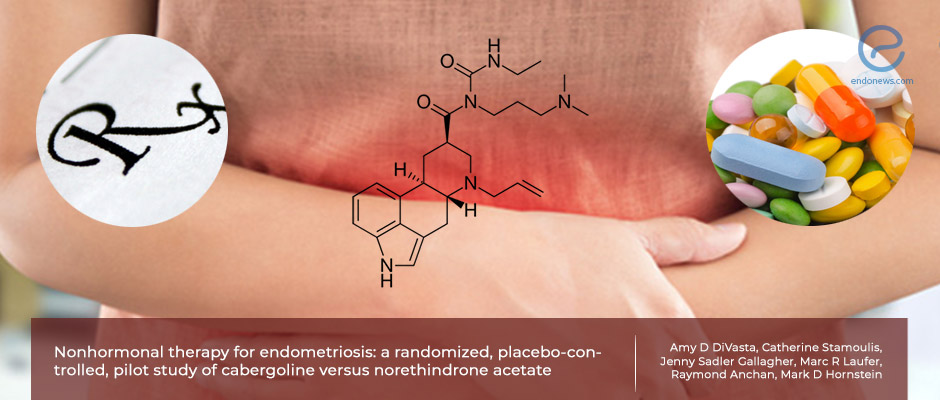Is "non-hormonal therapy" effective in women with endometriosis-associated pain?
Apr 4, 2022
Cabergoline, as a non-hormonal treatment option, may be a good alternative to relieve pain and ameliorate life quality in women with endometriosis.
Key Points
Highlights:
- Since endometriosis is associated with chronic pelvic pain, there is a need for safe and effective drugs for long-term use.
Importance:
- Women with endometriosis seeking relief of pain could be managed using Cabergoline based on its angiogenesis-inhibiting side effect.
What’s done here?
- A randomized, double-blind, placebo-controlled pilot study was conducted to evaluate the effectiveness and safety of "Cabergoline" in women with endometriosis, compared to the standard hormonal therapy.
- Women aged 15 to 40 years with laparoscopically confirmed endometriosis comprised the study population.
- Participants were randomized into two groups: Group1 received 5 mg of norethindrone acetate daily and a placebo tablet, Group 2 received oral 0.5 mg of cabergoline twice weekly, and a placebo tablet.
- The primary outcome was the assessment of pelvic pain in four domains (physical functioning, pain intensity, emotional functioning, and feeling of improvement).
- The Brief Pain Inventory interference scale, Visual analog scale score, the Beck Depression Inventory-II, and The Functional Disability Inventory scale was used as the questionnaires.
- Vascular endothelial growth factor, tumor necrosis factor-a, placental growth factor, intercellular adhesion molecule-1, vascular cell adhesion, molecule-1, VEGF receptor, monocyte chemotactic protein-1, interleukin 8, E-selectin, and IL-1b were measured in serum samples.
Key results:
- Four patients in the Cabergoline group and three women in the NETA group were included in the baseline evaluation and completed the 6-month controls.
- There was also no significant difference in the average pain and best or least pain between the groups.
- Improvements in their worst pain severity were more frequently encountered in the Cabergoline group.
- A moderate or high degree of change was detected up to 66% in the NETA group and 50% in the Cabergoline group using the patient global impression of change scale.
- None of the subjects showed a clinically meaningful amount of depressive symptoms at any time.
- Although all participants showed small declines in the serum VEGF concentrations, serum VEGF-R1 levels declined in the Cabergoline group and increased in the NETA group.
- The most common deleterious changes associated with both treatments were abdominal cramps or bloating, feeling tired, and weight gain.
Limitations and Strengths:
- The small sample size is a limitation of the study.
- The main strength is that this pilot study is the evaluation of the effectiveness of non-hormonal therapy for endometriosis-associated pain unresponsive to standard care.
Lay Summary
Women with endometriosis require effective treatment due to the negative impact of the disease on quality of life. Hormonal treatments including oral contraceptives, and progestins are usually recommended to suppress ovulation and decrease pelvic pain.
However, some women do not use these hormonal drugs regularly due to the side effects, while others are resistant to these drugs or inconvenient to use them. They continue to suffer from endometriosis-associated pain and seek other therapeutic options.
Dr. DiVasta et al, from Harvard, United States, published a study entitled “Nonhormonal therapy for endometriosis: a randomized, placebo-controlled, pilot study of cabergoline versus norethindrone acetate” in the journal named Fertility Sterility Reports. The authors aimed to assess the effectiveness of Cabergoline, as a non-hormonal treatment option, on endometriosis-associated pain compared to norethindrone acetate.
Cabergoline, a dopamine receptor 2 agonist, was predicted to be beneficial because of its ability to inhibit angiogenesis in endometriosis-associated pain. The authors randomized the participants into NETA and Cabergoline groups and evaluated them using questionnaires, and serum inflammatory markers in patients` serum.
Improvements in the worst pain severity were more frequently encountered in the Cabergoline group. A moderate or high degree of change was detected up to 66% in the NETA group and 50% in the Cabergoline group using the patient global impression of change scale. Although all participants showed small declines in the serum VEGF concentrations, serum VEGF-R1 levels declined in the Cabergoline group and increased in the NETA group. “This pilot study suggests that it is an effective therapeutic option for women with chronic pain due to endometriosis,” the authors added.
Research Source: https://pubmed.ncbi.nlm.nih.gov/34934987/
angiogenesis cabergoline endometriosis norethindrone acetate nonhormonal therapy

